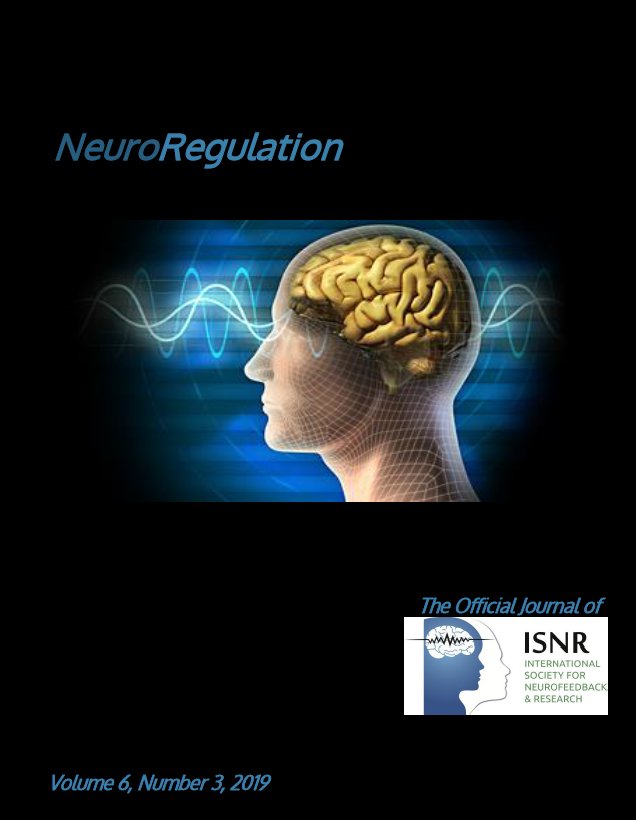Which quiets the mind more quickly and increases HRV: Toning or mindfulness?
DOI:
https://doi.org/10.15540/nr.6.3.128Keywords:
Toning, Mindfulness meditation, respiration, intrusive thoughts, mind wandering, heart rate variability, peacefulness, depression, relaxation, Stress managementAbstract
Disruptive thoughts interfere with concentration and performances. This report compares mindfulness practice (MP) with toning practice (TP) to reduce mind wandering and intrusive thoughts. Ninety-one undergraduate students (average age 22.4 years) began with either an MP or TP for 3 min. Respiration, blood volume pulse, and heart rate were monitored for 11 participants. The participants reported less mind wandering during TP (M = 3.7) than during MP (M = 6.5; p < .001), fewer intrusive thoughts during TP (M = 3.2) than during MP (M = 4.7; p < .001), and more body vibrations during TP (M = 6.2) than during MP (M = 2.3; p < .001) on a scale from 0 (not at all) to 10 (all the time). For participants with the highest self-reported rating of depression, TP was more effective in reducing mind wandering and intrusive thoughts than the MP (p < .001). There was no difference in self-reports in peacefulness, warmth, relaxation, anxiety, and depression between TP and MP. There was a decrease in respiration rate during TP (4.6 br/min) as compared to MP (11.6 br/min; p < .001) and an increase in heart rate variability during TP (SDNN = 103.7 ms; SD = 11.6) as compared to MP (SDNN = 61.9 ms; SD = 6.4). The findings suggest that TP is a powerful strategy to reduce mind wandering and intrusive thoughts.
References
Conder, R. L., & Conder, A. A. (2014). Heart rate variability interventions for concussion and rehabilitation. Frontiers in Psychology, 5, 890. https://doi.org/10.3389/fpsyg.2014.00890
Creswell, J. D. (2015). Mindfulness Interventions. Annual Review of Psychology, 68, 491–516. https://doi.org/10.1146/annurev-psych-042716-051139
Dahl, C. J., Lutz, A., & Davidson, R. J. (2015). Reconstructing and deconstructing the self: Cognitive mechanisms in meditation practice. Trends in Cognitive Sciences, 19(9), 515–523. https://doi.org/10.1016/j.tics.2015.07.001
Ginsberg, J. P., Berry, M. E., & Powell, D. A. (2010). Cardiac coherence and posttraumatic stress disorder in combat veterans. Alternative Therapies, 16(4), 52–60. https://pdfs.semanticscholar.org/6d27/e5a6084c5d824eca7e50c009413a912f7bf9.pdf?_ga=2.186430496.887517633.1561505930-1100946524.1561505930
Goessl, V. C., Curtiss, J. E., & Hofmann, S. G. (2017). The effect of heart rate variability biofeedback training on stress and anxiety: A meta-analysis. Psychological Medicine, 47(15), 2578–2586. https://doi.org/10.1017/S0033291717001003
Harne, B. P., & Hiwale, A. S. (2018). EEG spectral analysis on OM mantra meditation: A pilot study. Applied Psychophysiology and Biofeedback, 43(2), 123–129. https://doi.org/10.1007/s10484-018-9391-7
Hofmann, S. G., & Gómez, A. F. (2017). Mindfulness-based interventions for anxiety and depression. Psychiatric Clinics of North America, 40(4), 739–749. https://doi.org/10.1016/j.psc.2017.08.008
Kalyani, B. G., Venkatasubramanian, G., Arasappa, R., Rao, N. P., Kalmady, S. V., Behere, R. V., … Gangadhar, B. N. (2011). Neurohemodynamic correlates of 'OM' chanting: A pilot functional magnetic resonance imaging study. International Journal of Yoga, 4(1), 3–6. https://doi.org/10.4103/0973-6131.78171
Khazan, I. Z. (2013). The clinical handbook of biofeedback: A step-by-step guide for training and practice with mindfulness. Chichester, West Sussex, UK: John Wiley & Sons.
Khazan, I. Z. (2019). Biofeedback and Mindfulness in Everyday Life. New York, NY: W. W. Norton & Company.
Kopelman-Rubin, D., Omer, H., & Dar, R. (2017). Brief therapy for excessive worry: Treatment model, feasibility, and acceptability of a new treatment. Journal of Psychotherapy Integration. http://dx.doi.org/10.1037/int0000100
Lagos, L., Thompson, J., & Vaschillo, E. (2013). A preliminary study: Heart rate variability biofeedback for treatment of postconcussion syndrome. Biofeedback, 41(3), 136–143. https://doi.org/10.5298/1081-5937-41.3.02
Lehrer, P. M., & Gevirtz, R. (2014). Heart rate variability biofeedback: How and why does it work? Frontiers in Psychology, 5, 756. https://doi.org/10.3389/fpsyg.2014.00756
McGrady, A., & Moss, D. (2018). A pathways approach to chronic pain. In A. McGrady & D. Moss, Integrative Pathways (pp. 111–129). Cham, Switzerland: Springer International Publishing. https://doi.org/10.1007/978-3-319-89313-6_6
Ost, L. G. (2008). Efficacy of the third wave of behavioral therapies: A systematic review and meta-analysis. Behaviour Research and Therapy, 46(3), 296–321. https://doi.org/10.1016/j.brat.2007.12.005
Porges, S. W. (2017). Vagal pathways: Portals to compassion. The Oxford Handbook of Compassion Science, 189–204.
ProComp Infiniti 8-channel system with Biograph Infiniti software (Version 6.1) [Apparatus]. Montreal, Canada: Thought Technology, Ltd.
Renna, M. E., Quintero, J. M., Fresco, D. M., & Mennin, D. S. (2017). Emotion regulation therapy: A mechanism-targeted treatment for disorders of distress. Frontiers in Psychology, 8, 98. https://doi.org/10.3389/fpsyg.2017.00098
Shaffer, F., & Ginsberg, J. P. (2017). An overview of heart rate variability metrics and norms. Frontiers in Public Health, 5, 258. https://doi.org/10.3389/fpubh.2017.00258
Smith, J. M., & Alloy, L. B. (2009). A roadmap to rumination: A review of the definition, assessment, and conceptualization of this multifaceted construct. Clinical Psychology Review, 29(2), 116–128. https://doi.org/10.1016/j.cpr.2008.10.003
Snow, S., Bernardi, N. F., Sabet-Kassouf, N., Moran, D. & Lehmann, A. (2018). Exploring the Experience and Effects of Vocal Toning. Journal of Music Therapy, 55(2), 221–250. https://doi.org/10.1093/jmt/thy003
Thompson, M., & Thompson, L. (2015). The Neurofeedback Book: An Introduction to Basic Concepts in Applied Psychophysiology. Wheat Ridge, CO: Association for Applied Psychophysiology and Biofeedback.
van der Zwan, J. E., de Vente, W., Huizink, A. C., Bogels, S. M., & de Bruin, E. I. (2015). Physical activity, mindfulness meditation, or heart rate variability biofeedback for stress reduction: A randomized controlled trial. Applied Psychophysiology and Biofeedback, 40(4), 257–268. https://doi.org/10.1007/s10484-015-9293-x
Downloads
Published
Issue
Section
License
Authors who publish with this journal agree to the following terms:- Authors retain copyright and grant the journal right of first publication with the work simultaneously licensed under a Creative Commons Attribution License (CC-BY) that allows others to share the work with an acknowledgement of the work's authorship and initial publication in this journal.
- Authors are able to enter into separate, additional contractual arrangements for the non-exclusive distribution of the journal's published version of the work (e.g., post it to an institutional repository or publish it in a book), with an acknowledgement of its initial publication in this journal.
- Authors are permitted and encouraged to post their work online (e.g., in institutional repositories or on their website) prior to and during the submission process, as it can lead to productive exchanges, as well as earlier and greater citation of published work (See The Effect of Open Access).











